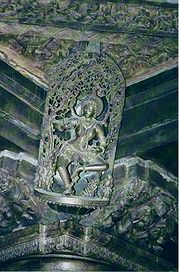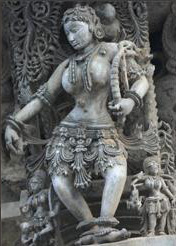
Salabhanjika
Encyclopedia


Sanskrit
Sanskrit , is a historical Indo-Aryan language and the primary liturgical language of Hinduism, Jainism and Buddhism.Buddhism: besides Pali, see Buddhist Hybrid Sanskrit Today, it is listed as one of the 22 scheduled languages of India and is an official language of the state of Uttarakhand...
śālabañjika meaning 'breaking a branch of a sala tree'. They are also known as madanakai, madanika or shilabalika.
Artistic tradition
The salabhanjika is a standard decorative element of Indian sculpture, a graceful stone sculpture representing a young female under a stylized tree in various poses, such as dancing, grooming herself or playing a musical instrument. The salabhanjika's female features, like breasts and hips, are often exaggerated. Frequently these sculpted figures display complex hairdos and an abundance of jewelry.The salabhanjika concept stems from ancient symbolism linking a chaste maiden with the sala tree or the asoka tree through the ritual called dohada, or the fertilisation of plants through contact with a young woman. The symbolism changed over the course of time and the salabhanjika became figures used as ornamental carvings, usually located in the area where worshipers engage in circumambulation
Circumambulation
Circumambulation is the act of moving around a sacred object.Circumambulation of temples or deity images is an integral part of Hindu ritual. It is also practised in Buddhism. In Islam, circumambulation is performed around the Kaaba in Mecca, in a counter-clockwise direction...
, near the garbhagriha
Garbhagriha
Garbhagriha or Garbha griha is the small unlit shrine of a Hindu temple.Garbhagriha or ' is a Sanskrit word meaning the interior of the sanctum sanctorum, the innermost sanctum of a Hindu temple where resides the murti of the primary deity of the temple...
of many Hindu
Hindu
Hindu refers to an identity associated with the philosophical, religious and cultural systems that are indigenous to the Indian subcontinent. As used in the Constitution of India, the word "Hindu" is also attributed to all persons professing any Indian religion...
temples.
Placed at an angle, salabhanjika figures also were used in temple architecture as a bracket figures.
Salabhanjikas are also often mentioned in ancient and modern Indian poetry, like in the Malayalam verses:
- Salabanjikakal kaikalil kusumathala menthi varavelkkum
Locations
Some of the most renowned salabanjika sculptures are to be found in the Hoysala temples of BelurBelur
Belur may refer to any of the following:* Belur, Karnataka, town in Karnataka, India* Belur, West Bengal, India, a locality on the west bank of the Hooghly River* Belur Math, the religious abbey located in Belur, West Bengal, India...
, Halebidu
Halebidu
Halebidu is located in Hassan District, Karnataka, India. Halebidu was the regal capital of the Hoysala Empire in the 12th century. It is home to one of the best examples of Hoysala architecture in the ornate Hoysaleswara and Kedareswara temples. Halebidu literally means ruined city...
and Somanathapura
Somanathapura
The Chennakesava Temple located at Somanathapura is one of the finest examples of Hoysala architecture. This temple was built by Soma, a Dandanayaka in 1268 under Hoysala king Narasimha III, when the Hoysala Empire was the major power in South India.-Deity and sculptures:The ceiling of the hall...
, in south-central Karnataka
Karnataka
Karnataka , the land of the Kannadigas, is a state in South West India. It was created on 1 November 1956, with the passing of the States Reorganisation Act and this day is annually celebrated as Karnataka Rajyotsava...
.
Another less-known location famous for its outstanding salabanjikas is a Chalukya period temple in Jalasangvi
Jalasangvi
Jalasangvi is a village in Homnabad Taluk, Bidar district, Karnataka, India. It is located close to Hudgi, on the Gulbarga - Bidar state highway, at the northern end of Karnataka State. Jalasangvi is famous for its temple ruins....
, Homnabad Taluk
Homnabad
Humnabad is a town in Bidar district in the Indian state of Karnataka. The town is also the headquarters of Humnabad Taluk. Humnabad is connected by two national highways NH 9 and NH 218....
on the Gulbarga
Gulbarga
Gulbarga is a city in the Indian state of Karnataka. It is the administrative headquarters of Gulbarga District. It was formerly part of Nizam's Hyderabad state...
-Bidar
Bidar
Bidar is a city in the Indian state of Karnataka. Located on the Deccan Plateau in the north-eastern part of Karnataka. It is the headquarters of the Bidar District....
state highway , at the northern end of Karnataka. Its well-endowed Madanika figures in seductive tribhanga poses are "...moon breasted, swan-waisted and elephant-hipped", according to the Indian art
Indian art
Indian Art is the visual art produced on the Indian subcontinent from about the 3rd millennium BC to modern times. To viewers schooled in the Western tradition, Indian art may seem overly ornate and sensuous; appreciation of its refinement comes only gradually, as a rule. Voluptuous feeling is...
istic canons. These older feminine sculptures were the source of inspiration for the later Hoysala bracket-figures.
Related iconography
The sal tree (Shorea robusta) is often confused with the ashoka treeAshoka tree
Saraca asoca is a plant belonging to the Caesalpiniaceae subfamily of the legume family. It is an important tree in the cultural traditions of the Indian Subcontinent and adjacent areas.-Description:...
(Saraca indica) in the ancient literature of the Indian Subcontinent
Indian subcontinent
The Indian subcontinent, also Indian Subcontinent, Indo-Pak Subcontinent or South Asian Subcontinent is a region of the Asian continent on the Indian tectonic plate from the Hindu Kush or Hindu Koh, Himalayas and including the Kuen Lun and Karakoram ranges, forming a land mass which extends...
. The position of the Salabhanjika is also related to the position of Queen Māyā of Sakya when she gave birth to Gautama Buddha
Buddha
In Buddhism, buddhahood is the state of perfect enlightenment attained by a buddha .In Buddhism, the term buddha usually refers to one who has become enlightened...
under an asoka tree in a garden in Lumbini
Lumbini
Lumbinī is a Buddhist pilgrimage site in the Rupandehi district of Nepal. It is the place where Queen Mayadevi gave birth to Siddhartha Gautama, who as the Buddha Gautama founded the Buddhist tradition. The Buddha lived between roughly 563 and 483 BCE...
, while grasping its branch.

